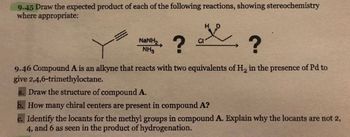
Chemistry
10th Edition
ISBN: 9781305957404
Author: Steven S. Zumdahl, Susan A. Zumdahl, Donald J. DeCoste
Publisher: Cengage Learning
expand_more
expand_more
format_list_bulleted
Concept explainers
Question

Transcribed Image Text:9.45 Draw the expected product of each of the following reactions, showing stereochemistry
where appropriate:
me
?
?
9.46 Compound A is an alkyne that reacts with two equivalents of H₂ in the presence of Pd to
give 2,4,6-trimethyloctane.
Maho
NH3
Draw the structure of compound A.
How many chiral centers are present in compound A?
Identify the locants for the methyl groups in compound A. Explain why the locants are not 2,
4, and 6 as seen in the product of hydrogenation.
Expert Solution
This question has been solved!
Explore an expertly crafted, step-by-step solution for a thorough understanding of key concepts.
This is a popular solution
Trending nowThis is a popular solution!
Step by stepSolved in 3 steps with 2 images

Knowledge Booster
Learn more about
Need a deep-dive on the concept behind this application? Look no further. Learn more about this topic, chemistry and related others by exploring similar questions and additional content below.Similar questions
- A a. Draw the structure of both products B and C of these following transformations. ( 1) O3, CH₂Cl2, -78 °C CrO3, H₂SO4 2) (CH3)2S H₂O:Acetone B сarrow_forward7.49 Using E-Z designators, identify the configuration of each C=C double bond in the following compound: Br. Il.. Br Dactylyne A natural product isolated from marine sourcesarrow_forwardSuggest a suitable series of reactions for carrying out the following synthetic transformation. You must state and identify each step you made and you must also state why the order of the steps was important. (6 pts) OCH3 4. OCH3 O2N. to OCH3 OCH3 Č(CH3)3arrow_forward
- 4. 5. Which compound will react faster with NaOCH3 in methanol (50°C)? A) A) C) O₂N A) C) CI B) LOCH3 A) A B) B C) C D) D N(CH3)2 Which compound will react faster with Br₂ in acetic acid? OCCH3 CI B) D) C) B) 6. Which of the following is an aromatic hydrocarbon? CH3O D) O₂N D) CI CF3 NO₂arrow_forwardOxaloacetic acid is an important intermediate in the biosynthesis of citric acid. Synthesize oxaloacetic acid using a mixed Claisen condensation as a key carbon-carbon bond forming reaction. (5) LOH HO 0 oxaloacetic acidarrow_forward6. Draw all of the stereoisomers that you would form in the reaction of CHCl3 and KOTBU given the following starting materials a-c. b. 7. Draw the product is formed when each alkene is treated with CH212 and Zn(Cu)? a. - 8. Draw the products for the following Grubbs ring-closing metatheses with the following starting materials. 3 а. b. كلمة b. C. bearrow_forward
- 4) (10 pts) Draw all substitution products that are obtained from the major intermediate in the following reaction: Show the major intermediate CI CH3CH2OH Gentle heatarrow_forwardDraw the product formed when the structure shown below undergoes substitution with OH. Interactive 3D display mode ÇH, H Brl Draw the molecule on the canvas by choosing buttons from the Tools (for bonds), Atoms, and Advanced Template toolbars. The single bond is active by default. Show the appropriate stereochemistry by choosing the dashed or wedged buttons and then clicking a bond on the canvas. O O ® H: EXP. -(7)- %3D H. Carrow_forwardroad maparrow_forward
- What is the structure of cyclopentyl cyclobutanecarboxylate? A 0arrow_forwardHeating compound A results in two phenols B and C through sigmatropic rearrangement. B and C are a pair of constitutional isomers. Draw the structures of B and C. Propose a reasonable mechanism for this reaction using curved arrows to indicate the formation and breaking of bonds. (7 points) 186 °C B + C 5 h Aarrow_forwardName the type of reaction and provide a possible reagent assign all the stereocentres found in the compounds via cahn ingold prelog rules define the relation between compound. D E F G identify the 2 stereoisomers likely to be formed in compound carrow_forward
arrow_back_ios
arrow_forward_ios
Recommended textbooks for you
 ChemistryChemistryISBN:9781305957404Author:Steven S. Zumdahl, Susan A. Zumdahl, Donald J. DeCostePublisher:Cengage Learning
ChemistryChemistryISBN:9781305957404Author:Steven S. Zumdahl, Susan A. Zumdahl, Donald J. DeCostePublisher:Cengage Learning ChemistryChemistryISBN:9781259911156Author:Raymond Chang Dr., Jason Overby ProfessorPublisher:McGraw-Hill Education
ChemistryChemistryISBN:9781259911156Author:Raymond Chang Dr., Jason Overby ProfessorPublisher:McGraw-Hill Education Principles of Instrumental AnalysisChemistryISBN:9781305577213Author:Douglas A. Skoog, F. James Holler, Stanley R. CrouchPublisher:Cengage Learning
Principles of Instrumental AnalysisChemistryISBN:9781305577213Author:Douglas A. Skoog, F. James Holler, Stanley R. CrouchPublisher:Cengage Learning Organic ChemistryChemistryISBN:9780078021558Author:Janice Gorzynski Smith Dr.Publisher:McGraw-Hill Education
Organic ChemistryChemistryISBN:9780078021558Author:Janice Gorzynski Smith Dr.Publisher:McGraw-Hill Education Chemistry: Principles and ReactionsChemistryISBN:9781305079373Author:William L. Masterton, Cecile N. HurleyPublisher:Cengage Learning
Chemistry: Principles and ReactionsChemistryISBN:9781305079373Author:William L. Masterton, Cecile N. HurleyPublisher:Cengage Learning Elementary Principles of Chemical Processes, Bind...ChemistryISBN:9781118431221Author:Richard M. Felder, Ronald W. Rousseau, Lisa G. BullardPublisher:WILEY
Elementary Principles of Chemical Processes, Bind...ChemistryISBN:9781118431221Author:Richard M. Felder, Ronald W. Rousseau, Lisa G. BullardPublisher:WILEY

Chemistry
Chemistry
ISBN:9781305957404
Author:Steven S. Zumdahl, Susan A. Zumdahl, Donald J. DeCoste
Publisher:Cengage Learning

Chemistry
Chemistry
ISBN:9781259911156
Author:Raymond Chang Dr., Jason Overby Professor
Publisher:McGraw-Hill Education

Principles of Instrumental Analysis
Chemistry
ISBN:9781305577213
Author:Douglas A. Skoog, F. James Holler, Stanley R. Crouch
Publisher:Cengage Learning

Organic Chemistry
Chemistry
ISBN:9780078021558
Author:Janice Gorzynski Smith Dr.
Publisher:McGraw-Hill Education

Chemistry: Principles and Reactions
Chemistry
ISBN:9781305079373
Author:William L. Masterton, Cecile N. Hurley
Publisher:Cengage Learning

Elementary Principles of Chemical Processes, Bind...
Chemistry
ISBN:9781118431221
Author:Richard M. Felder, Ronald W. Rousseau, Lisa G. Bullard
Publisher:WILEY